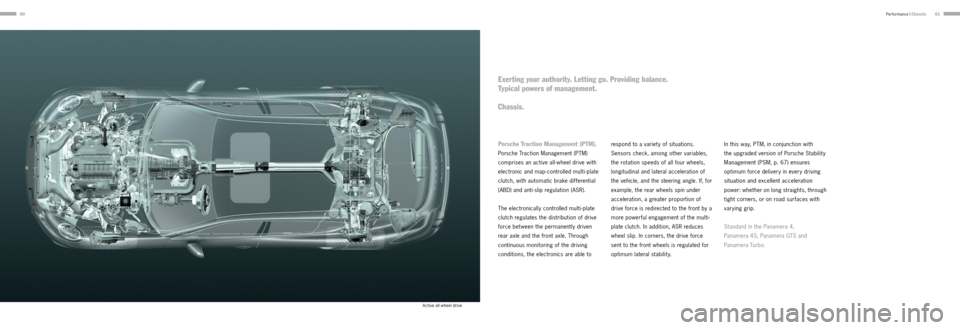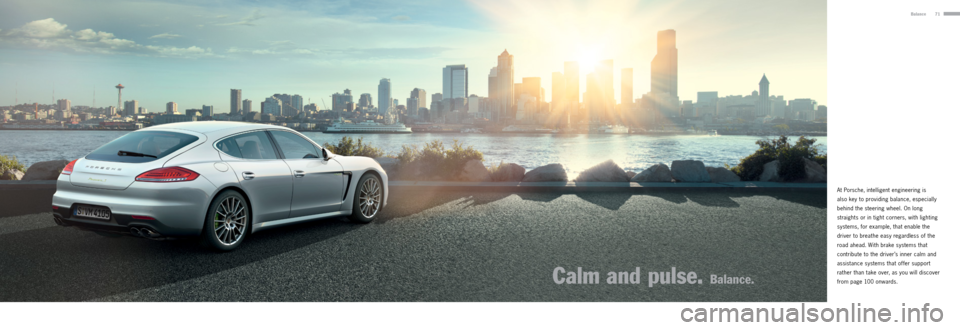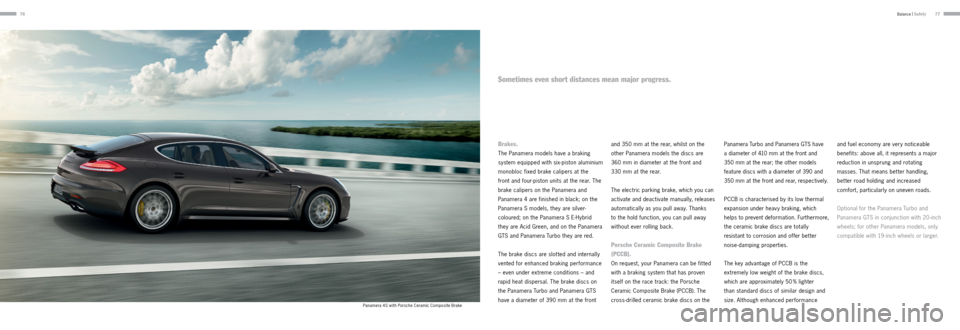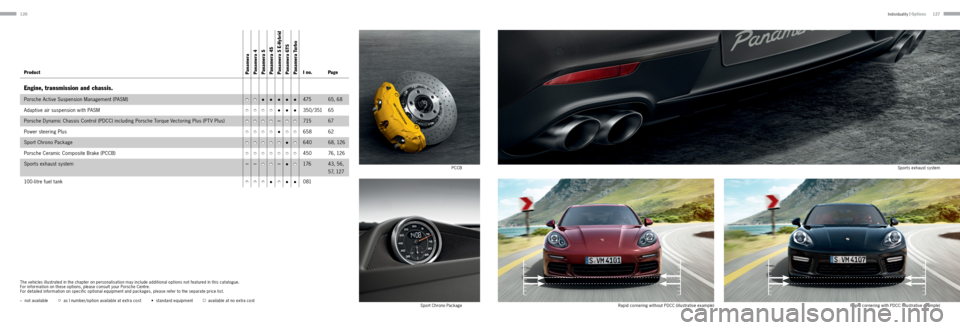2013 PORSCHE PANAMERA brake
[x] Cancel search: brakePage 30 of 78

6061
Porsche Traction Management (PTM).
Porsche Traction Management (PTM)
comprises an active all-wheel drive with
electronic and map - controlled multi - plate
clutch, with automatic brake differential
(ABD) and anti-slip regulation (ASR).
The electronically controlled multi - plate
clutch regulates the distribution of drive
force bet ween the permanently driven
rear axle and the front axle. Through
continuous monitoring of the driving
conditions, the electronics are able to respond to a variet y of situations.
Sensors check, among other variables,
the rotation speeds of all four wheels,
longitudinal and lateral acceleration of
the vehicle, and the steering angle. If, for
example, the rear wheels spin under
acceleration, a greater proportion of
drive force is redirected to the front by a
more powerful engagement of the multi-
plate clutch. In addition, ASR reduces
wheel slip. In corners, the drive force
sent to the front wheels is regulated for
optimum lateral stability.
Exerting your authority. Letting go. Providing balance.
Typical powers of management.
Chassis.
In this way, PTM, in conjunction with
the upgraded version of Porsche Stabilit y
Management (PSM, p. 67) ensures
optimum force delivery in every driving
situation and excellent acceleration
power: whether on long straights, through
tight corners, or on road surfaces with
varying grip.
Standard in the Panamera 4,
Panamera 4S, Panamera GTS and
Panamera Turbo.
Active all-wheel drive
Performance |
Chassis
Page 35 of 78

71Balance
At Porsche, intelligent engineering is
also key to providing balance, especially
behind the steering wheel. On long
straights or in tight corners, with lighting
systems, for example, that enable the
driver to breathe easy regardless of the
road ahead. With brake systems that
contribute to the driver’s inner calm and
assistance systems that of fer support
rather than take over, as you will discover
from page 100 onwards.
Calm and pulse. Balance.
Page 36 of 78

7273
Lighting concept.
Standard in all new Panamera models:
Bi-Xenon headlights featuring automatic
and dynamic range adjustment, a
headlight cleaning system and integral
day time running lights with four LED
spotlights in each headlight. On the
new Panamera GTS, the headlight units
are finished in black.
The Porsche Dynamic Light System
(PDLS) is standard in the Panamera Turbo
and Panamera GTS, and available on
request for all other models. Its dynamic cornering light function
swivels the headlights towards the inside
of the bend, based on the steering angle
and driving speed. The static cornering
lights activate the auxiliary headlights
in order to illuminate more of the road
at tight bends and turns. In addition,
beam distribution is continuously adapted
in line with driving speed and prevailing
light conditions. Another function is
the adverse weather function. This is
activated whenever the rear fog light
is switched on and improves safet y
by reducing the dazzle to which you
are exposed and by providing bet ter
illumination of the kerbside.
Automatic headlight activation is standard
in all models and switches the lights on
automatically when it gets dark. The
lighting system also includes an auto matic
switch- off feature and the ‘Welcome
Home’ function – a customi sable delayed
switch- off timer that keeps the day time
running lights and the taillights switched
on until you reach your front door.
Adaptive LED brake lights are fit ted as
standard and pulsate in the event of panic
braking, thereby alerting following traffic
more quickly to a critical situation.
Sometimes, looking ahead also means thinking about
what’s around the next corner.
Safety.
Night light design of the Bi -Xenon headlights Night light design
Balance |
Safety
Page 38 of 78

7677
Sometimes even short distances mean major progress.
Brakes.
The Panamera models have a braking
system equipped with six-piston aluminium
monobloc fixed brake calipers at the
front and four-piston units at the rear. The
brake calipers on the Panamera and
Panamera 4 are finished in black; on the
Panamera S models, they are silver-
coloured; on the Panamera S E-Hybrid
they are Acid Green, and on the Panamera
GTS and Panamera Turbo they are red.
The brake discs are slot ted and internally
vented for enhanced braking performance
– even under extreme conditions – and
rapid heat dispersal. The brake discs on
the Panamera Turbo and Panamera GTS
have a diameter of 390 mm at the front and 350 mm at the rear, whilst on the
other Panamera models the discs are
360 mm in diameter at the front and
330 mm at the rear.
The electric parking brake, which you can
activate and deactivate manually, releases
automatically as you pull away. Thanks
to the hold function, you can pull away
without ever rolling back.
Porsche Ceramic Composite Brake
(PCCB).
On request, your Panamera can be fit ted
with a braking system that has proven
itself on the race track: the Porsche
Ceramic Composite Brake (PCCB). The
cross-drilled ceramic brake discs on the
Panamera Turbo and Panamera GTS have
a diameter of 410 mm at the front and
350 mm at the rear; the other models
feature discs with a diameter of 390 and
350 mm at the front and rear, respectively.
PCCB is characterised by its low thermal
expansion under heavy braking, which
helps to prevent deformation. Furthermore,
the ceramic brake discs are totally
resistant to corrosion and of fer bet ter
noise-damping properties.
The key advantage of PCCB is the
extremely low weight of the brake discs,
which are approximately 50 % lighter
than standard discs of similar design and
size. Although enhanced performance and fuel economy are very noticeable
benefits: above all, it represents a major
reduction in unsprung and rotating
masses. That means better handling,
bet ter road holding and increased
comfort, particularly on uneven roads.
Optional for the Panamera Turbo and
Panamera GTS in conjunction with 20-inch
wheels; for other Panamera models, only
compatible with 19-inch wheels or larger.
Panamera 4S with Porsche Ceramic Composite Brake
Balance |
Safety
Page 51 of 78

102103
Park Assis t.
Park Assist is standard in all Panamera
models. With four sensors in the rear
end, the system audibly alerts the driver
to the presence of obstacles detected
behind the vehicle. An intermit tent
warning tone increases in rapidity as the
obstacle is approached. An enhanced
version of Park Assist, which includes
six sensors in the front end, is fit ted
as standard in the Panamera Turbo
and available as an option in the other
models. The audible alert is supplemented
by a visual warning in the central display
screen which provides a graphical
representation of the vehicle’s proximit y
to obstacles.
Reversing camera.
The optional reversing camera facilitates
precise reverse parking and manoeuvring
and also assists in hitching a trailer. Help
is provided in the form of the camera
image and the dynamic, superimposed
guidelines on the PCM screen, which
illustrate the predicted course of the
vehicle given the current position of the
steering wheel.
Surround View.
The optionally available Surround View
system supplements the reversing
camera with three more high-resolution
cameras – one in the front apron and one
in each lower trim of the exterior mirrors.
Based on the information supplied by
all four cameras, the system generates a virtual bird’s eye view of the car and
displays it on the PCM screen. This
provides additional assistance to the
driver when parking and manoeuvring
because even low-level obstacles to
the front and side of the vehicle can be
detected. It is also possible to switch
bet ween various camera views to
improve visibility, for example at narrow
exits.
Cruise control.
Cruise control is fit ted as standard for
added driver comfort on long stretches
of road. Cruise control operates in the
30 to 240 km/ h speed range and is
selected using a but ton on the steering
column control stalk.
Adaptive cruise control including
Porsche Active Safe (PAS).
Available as an option, this enhanced
version of cruise control regulates the
speed of your vehicle in line with the
speed of the vehicle in front. A radar
sensor inside in the front end scans the
road ahead up to a distance of 200 m.
Imagine you’ve selected a cruising speed
but have begun to gain on the vehicle in
front because it is driving more slowly –
the system reduces the speed of your
vehicle by restricting throt tle or gently
applying the brakes until your chosen
distance from the vehicle in front is
maintained. For safety reasons, the driver
should always be prepared to intervene
manually if heavier braking is required.
If the vehicle ahead slows further,
adaptive cruise control will decelerate
your Panamera accordingly – even down
to a halt. As soon as the road ahead
clears, your vehicle will accelerate back
up to the cruising speed originally set.
Selectable cruising speeds range from
30 to 210 km/ h. To pull away after an
automatic stop, simply press the control
lever or depress the accelerator pedal.
If desired, the driver can enable the
integrated stop -and -go function, which
automates stopping and pulling away in
congested traf fic. Safet y is further improved by Porsche
Active Safe (PAS). If you are approaching
the vehicle in front too quickly, you will
be prompted to take the necessary
action by an audible and visual warning
as well as a jolt of the brakes. The
system may also intervene with targeted
braking applications and act to boost
brake pressure as the situation demands,
even to the point of the maximum braking
force that the system is able to provide.
Graphical display of the ParkAssist (front and rear)
Reversing camera
Perso na li t y |
Assistance systems
Page 62 of 78

126127
Product Panamera
Panamera 4
Panamera S
Panamera 4S
Panamera S E-Hybrid
Panamera GTS
Panamera TurboI no. Page
Engine, transmission and chassis.
Porsche Active Suspension Management (PASM)•••••••475 65, 6 8
Adaptive air suspension with PASM
•••• •••350/351 65
Porsche Dynamic Chassis Control (PDCC) including Porsche Torque Vectoring Plus (PT V Plus)
•••• –••715
67
Power steering Plus
•••• •••658 62
Sport Chrono Package
••••• ••640 6 8 , 12 6
Porsche Ceramic Composite Brake (PCCB)
•••••••450 76 , 12 6
Sports exhaust system
– –••–
••176 43, 56,
5 7, 12 7
100 -litre fuel tank
••• ••••081
PCCB
Sport Chrono Package Sports exhaust system
Rapid cornering without PDCC (illustrative example) Rapid cornering with PDCC (illustrative example)
The vehicles illustrated in the chapter on personalisation may include additional options not featured in this catalogue.
For information on these options, please consult your Porsche Centre.
For detailed information on specific optional equipment and packages, please refer to the separate price list.
– not available
as I number/option available at extra cost • standard equipment available at no extra cost
Individuality |
Options
Page 72 of 78

146147
Panamera Panamera 4
Engine
C y linders 6 6
Displacement 3,605 cm33,605 cm3
Max. power (DIN) at rpm228 kW (310 hp) at 6,200 228 kW (310 hp) at 6,200
Max. torque at rpm 400 Nm at 3,750 400 Nm at 3,750
Compression ratio 12.5 : 1 12.5 : 1
Transmission
LayoutRear-wheel drive All-wheel drive
PDK (7-speed) Standard Standard
Tiptronic S (8-speed) – –
Chassis
Front axleAluminium double-wishbone Aluminium double-wishbone
Rear axle Aluminium multi-link with chassis subframe Aluminium multi-link with chassis subframe
Steering Variable steering ratio, power-assisted Variable steering ratio, power-assisted
Brakes Six-piston monobloc aluminium fixed calipers (front),
four-piston monobloc aluminium fixed calipers (rear),
integral brake discs internally vented and cross- drilled Six-piston monobloc aluminium fixed calipers (front),
four-piston monobloc aluminium fixed calipers (rear),
integral brake discs internally vented and cross- drilled
Standard wheels Front: 8 J x 18 ET 59, Rear: 9 J x 18 ET 53 Front: 8 J x 18 ET 59, Rear: 9 J x 18 ET 53
Standard t yres Front: 245/50 ZR 18, Rear: 275/45 ZR 18 Front: 245/50 ZR 18, Rear: 275/45 ZR 18
Panamera S Panamera 4S
Engine
C y linders 6 6
Displacement 2,997 cm32,997 cm3
Max. power (DIN) at rpm309 kW (420 hp) at 6,000 309 kW (420 hp) at 6,000
Max. torque at rpm 520 Nm bet ween 1,750 and 5,000 520 Nm bet ween 1,750 and 5,000
Compression ratio 9.8 : 1 9.8 : 1
Transmission
LayoutRear-wheel drive All-wheel drive
PDK (7-speed) Standard Standard
Tiptronic S (8-speed) – –
Chassis
Front axleAluminium double-wishbone Aluminium double-wishbone
Rear axle Aluminium multi-link with chassis subframe Aluminium multi-link with chassis subframe
Steering Variable steering ratio, power-assisted Variable steering ratio, power-assisted
Brakes Six-piston monobloc aluminium fixed calipers (front),
four-piston monobloc aluminium fixed calipers (rear),
integral brake discs internally vented and cross- drilled Six-piston monobloc aluminium fixed calipers (front),
four-piston monobloc aluminium fixed calipers (rear),
integral brake discs internally vented and cross- drilled
Standard wheels Front: 8 J x 18 ET 59, Rear: 9 J x 18 ET 53 Front: 8 J x 18 ET 59, Rear: 9 J x 18 ET 53
Standard t yres Front: 245/50 ZR 18, Rear: 275/45 ZR 18 Front: 245/50 ZR 18, Rear: 275/45 ZR 18
Technical data
Page 73 of 78

148149Technical data
Panamera S E-Hybrid Panamera GTS
Engine
C y linders 6 8
Displacement 2,995 cm34,806 cm3
Max. power (DIN) at rpm245 kW (333 hp) bet ween 5,500 and 6,500 324 kW (440 hp) at 6,700
Max. torque at rpm 440 Nm bet ween 3,000 and 5,250 520 Nm at 3,500
Compression ratio 10.5 : 1 12.5 : 1
Max. power electric motor at rpm 70 kW (95 hp) bet ween 2,200 and 2,600 –
Max. torque electric motor at rpm 310 Nm < 1,700 –
Max. power parallel full hybrid at rpm 306 kW (416 hp) at 5,500 –
Max. torque parallel full hybrid at rpm 590 Nm bet ween 1,250 and 4,000 –
Transmission
LayoutRear-wheel drive All-wheel drive
PDK (7-speed) – Standard
8-speed Tiptronic S Standard –
Chassis
Front axleAluminium double-wishbone Aluminium double-wishbone
Rear axle Aluminium multi-link with chassis subframe Aluminium multi-link with chassis subframe
Steering Variable steering ratio, power-assisted Variable steering ratio, power-assisted
Brakes Six-piston monobloc aluminium fixed calipers (front),
four-piston monobloc aluminium fixed calipers (rear),
integral brake discs internally vented and cross- drilled Six-piston monobloc aluminium fixed calipers (front),
four-piston monobloc aluminium fixed calipers (rear),
composite brake discs (front), integral brake discs (rear),
internally vented and cross- drilled
Standard wheels Front: 8 J x 18 ET 59, Rear: 9 J x 18 ET 53 Front: 9 J x 19 ET 60, Rear: 10 J x 19 ET 61
Standard t yres Front: 245/50 ZR 18, Rear: 275/45 ZR 18 Front: 255/45 ZR 19, Rear: 285/40 ZR 19
Panamera Turbo
Engine
C y linders 8
Displacement 4,806 cm3
Max. power (DIN) at rpm382 kW (520 hp) at 6,000
Max. torque at rpm 700 Nm bet ween 2,250 and 4,500
Compression ratio 10.5 : 1
Max. power electric motor at rpm –
Max. torque electric motor at rpm –
Max. power parallel full hybrid at rpm –
Max. torque parallel full hybrid at rpm –
Transmission
LayoutAll-wheel drive
PDK (7-speed) Standard
Tiptronic S (8-speed) –
Chassis
Front axleAluminium double-wishbone
Rear axle Aluminium multi-link with chassis subframe
Steering Variable steering ratio, power-assisted
Brakes Six-piston monobloc aluminium fixed calipers (front),
four-piston monobloc aluminium fixed calipers (rear),
composite brake discs (front), integral brake discs (rear),
internally vented and cross- drilled
Standard wheels Front: 9 J x 19 ET 60, Rear: 10 J x 19 ET 61
Standard t yres Front: 255/45 ZR 19, Rear: 285/40 ZR 19